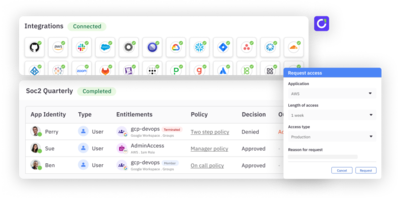Zero trust is a security concept and framework that assumes that all users, devices, and systems are potentially compromised – whether inside or outside of the network, local, in the cloud, or a combination.
In a zero trust environment, all network traffic is treated as untrusted and must be authorized, verified, and authenticated before access is granted. Zero trust can be implemented through a variety of mechanisms, such as identity security, device and network security, and continuous monitoring and assessment of systems and policies in place.
The goal of zero trust is to reduce the risk of unauthorized access to resources by implementing a strategy that goes beyond the traditional perimeter-based approach. The traditional security approach includes measures such as firewalls, intrusion detection, and prevention systems that act like security checkpoints, similar to physical perimeters like walls and doors. This can help organizations protect against both external and internal threats, such as cyber attacks and data breaches.
Why is zero trust important?
Zero trust is important for several reasons, including:
- Protection against cyber threats: With zero trust, all agencies and accounts are treated as untrusted and must be authenticated as a trusted body before granting access. This can help protect against cyber threats such as malware, phishing, and data breaches by making it more difficult for attackers to gain unauthorized access to resources.
- Compliance with regulations: Many regulations, such as HIPAA and GDPR, require organizations to protect personal and financial information and enforce strict access controls. Zero trust can help organizations comply with these regulations by implementing security measures that go beyond the traditional perimeter-based security approach.
- Improved security for a remote world: With the increasing number of remote workers, traditional perimeter-based security solutions are becoming less effective. Zero trust can help organizations secure remote access through the use of a comprehensive security strategy that includes multi-factor and FIDO-based authentication and network segmentation.
- Improved operational efficiency: Zero trust can help organizations improve operational efficiency by automating and streamlining access control and identity management processes. This can help reduce the risk of human error and improve overall security.
- Reducing the attack surface: With the zero trust approach, organizations can reduce the attack surface by limiting access only to what is strictly necessary.
In summary, zero trust is important because it helps organizations protect against cyber threats, comply with regulations, secure remote access, improve operational efficiency, and reduce their attack surface. Zero trust is becoming more relevant as the threat landscape is changing and organizations are looking for more robust security solutions to protect sensitive data and systems.
How are zero trust and least privilege related?
Zero trust and least privilege access are closely related concepts. The zero trust security model assumes that all users and devices are untrusted to ensure that the correct and authenticated users access the necessary devices and information. Least privilege is a security principle that states that a user or program should have the minimum level of access necessary to perform its intended function.
In a zero trust model, least privilege access is implemented as a way to ensure that users and devices are only granted the access to resources that they need to do their jobs and no more, regardless of their location or device. This limits the potential damage that can be caused by a security breach or by a user or device with malicious intent. By implementing least privilege access in a zero trust model, organizations can improve their overall security posture and reduce the risk of a successful cyber attack.
How can you implement zero trust?
There are several ways to implement a zero trust model, some of the most common include:
- Identity security: Implementing the principle of least privilege access, where users are only given the minimum amount of access they need to do their job, multi-factor authentication, and identity access management systems can all help to strengthen security with the zero trust ideology.
- Network security: Network segmentation can be used to isolate sensitive resources and restrict access to them. This can help prevent attackers from moving laterally through the network and accessing sensitive data.
- Device trust: Ensure that all devices that access the network are trusted and secure. This can include implementing device profiling, device posture assessment, and device quarantine mechanisms.
- Micro-segmentation: Micro-segmentation can be used to create granular security policies that apply to specific users, devices, or applications. This can help reduce the attack surface and improve security.
- Continuous monitoring and assessment: Regularly monitor and assess the system for any suspicious activity, misconfigurations or compliance issues.
- Regularly review and update policies: Security measures need to be able to adapt to the ever-evolving threat landscape, so policies and controls should be periodically reviewed and updated
It’s important to note that zero trust is not a one-time implementation, but a continuous effort to adapt to the organization’s needs. It’s also important to involve all the stakeholders and have a clear understanding of the organization’s assets, data flow, and access requirements to implement a zero trust model effectively.
Summary
Zero trust is based on the principle of “never trust, always verify” to promote the security of sensitive information and resources. This model can help prevent breaches and keep up to date with compliance regulations, as well as increase efficiency. Zero trust can be applied through identity security, network security, device trust, and continued monitoring and review of the systems in place.



